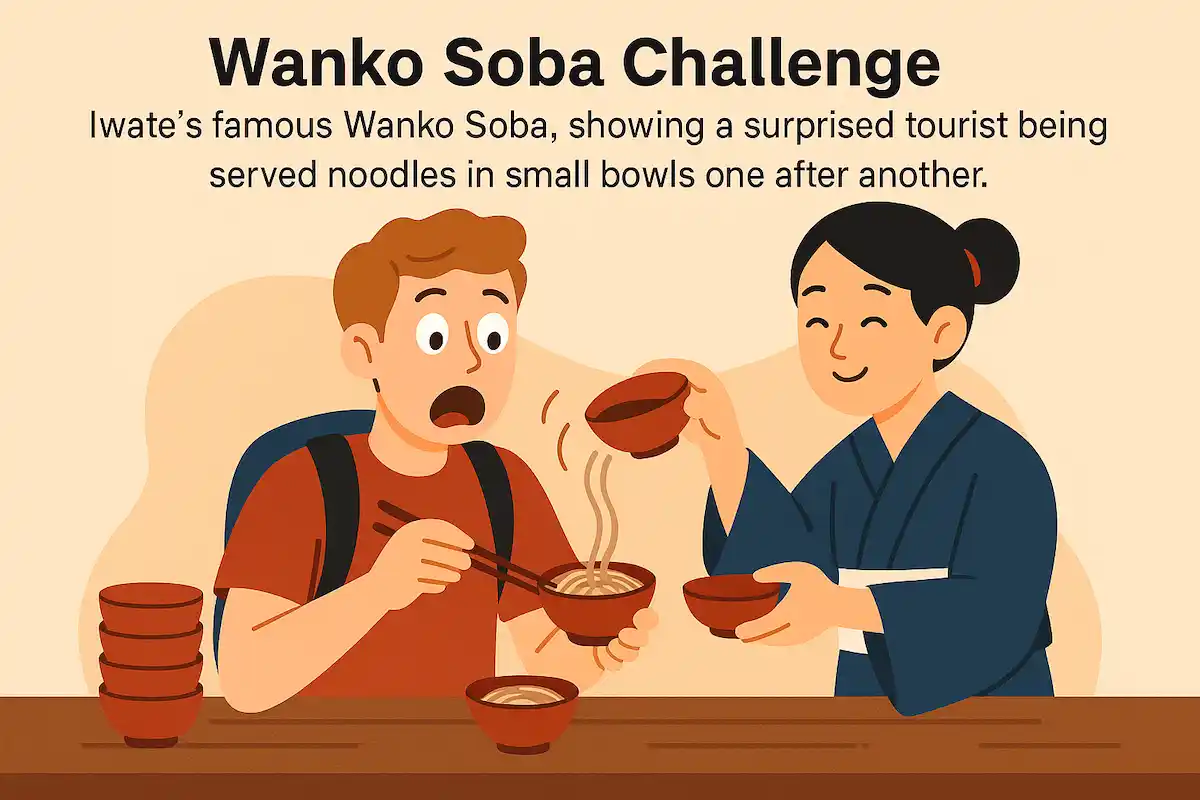わんこそばを英語で説明・紹介するための基本情報と、英会話に役立つ表現をシンプルでわかりやすい英語で紹介します。
英会話ダイアローグ・関連情報を通して、わんこそばに関する英語表現を学びます。
英語
英会話ダイアローグを読む前に知っておくと良い前提知識と情報です。
- わんこそばとは
- わんこそばは岩手県の郷土料理で、特に盛岡市や花巻市で有名
- 小さなボウルに入ったそばを次々に食べるスタイルで、食べきれるだけそばを提供し続ける食べ放題形式が特徴
- わんこそばの食べ方
- わんこそばは「はい、どんどん」と店員が声をかけながら小さなボウルにそばを次々に供するスタイル
- 食べ終わるごとに新しいボウルが供され、食べるのをやめたい時はボウルに蓋をすることで終了の合図をする
- わんこそば大会
- 毎年、わんこそばをどれだけ食べられるかを競う大会が開催されている
- 特に2月11日に花巻で行われる大会が有名で、多くの参加者や観光客が訪れる
- 外国人にも人気
- わんこそばは外国人観光客にも人気があり、日本の文化や食事を楽しむユニークな体験として注目されている
- 盛岡市のおすすめ店
- わんこそばを提供する店舗はいくつかあるが、特に盛岡市にある「東家本店」は老舗であり、おすすめの一つとしてよく紹介される
2人がわんこそばについて話しています。
毎年2月11日に花巻で開催されるわんこそばの大会、わんこそばのユニークな食べ方、それを体験できる場所について話題にしています。また、外国人にも人気があることや、盛岡にあるおすすめのわんこそばの名店についても触れています。
会話 / dialogue

Hey Key, did you hear about the Wanko Soba competition in Hanamaki on February 11th?

Yeah, I saw it online. It’s quite a spectacle, isn’t it? Competitors eat as many bowls of soba as they can. Sounds fun!

Absolutely! I’ve been reading up on Wanko Soba. It’s an all-you-can-eat soba noodle experience, unique to Iwate Prefecture. I’d love to try it if we go to Morioka.

I know, right? The idea of eating soba noodles from tiny bowls and having them continuously refilled sounds delightful. And the fact that you signal you’re done by covering the bowl is pretty interesting.

Exactly, and it’s not just about eating; it’s a celebration of hospitality. Plus, I read that foreigners really enjoy the experience. It’s a great way to dive into Japanese culture.

Did you find out where we can try it?

Yes, Azumaya Honten in Morioka is one of the most recommended places. They’ve been serving Wanko Soba since 1907. It comes with a variety of side dishes too.

That sounds amazing! And it’s not just a meal; it’s more like an event with all the encouragement from the staff shouting “Hai, Janjan!” as they refill your bowl.

Exactly! And I heard if you finish more than 100 bowls, you get a special wooden plaque. It’s a challenge I’m willing to take.

Me too. Plus, it’s a chance to explore Morioka. There’s so much more to see and do there besides eating Wanko Soba.

Definitely! Let’s plan a trip. It’ll be an adventure, exploring the culture, food, and maybe setting a new personal record for soba eating.

Count me in! This is going to be an experience we won’t forget.

Can’t wait! Let’s start planning and make sure we’re hungry when we get there.
関連情報 / related information
「わんこそば」について、理解を深めるための「英語での関連情報」です。
わんこそば

Introduction to Wanko Soba
Wanko Soba is a unique and fun Japanese noodle experience originating from Iwate Prefecture. It’s especially popular in cities like Morioka and Hanamaki. Unlike regular noodle servings, Wanko Soba is served in tiny bowls, offering a challenge to eat as much as you can.
How It’s Served
During a Wanko Soba meal, servers continuously fill your small bowl with soba noodles as soon as you finish each serving. The phrase “Hai, Janjan!” is often shouted, encouraging you to eat more. You signal that you’re full by covering your bowl with a lid, ending the endless servings.
The Cultural Significance
Wanko Soba is not just about eating; it’s a celebration of hospitality and community. It reflects the Japanese spirit of omotenashi, or selfless hospitality, making it a memorable experience for both locals and tourists. The meal is also a playful competition, seeing how many bowls you can consume.
Competitions and Popularity
Annually, Wanko Soba competitions are held, attracting participants eager to set new records. The event in Hanamaki on February 11th is particularly famous. This tradition has also become a favorite among foreign visitors, showcasing the global appeal of this local Japanese culinary practice.
Where to Experience
For those looking to try Wanko Soba, Morioka’s Azumaya Honten comes highly recommended. Established in 1907, it provides a genuine and traditional Wanko Soba experience, complete with various side dishes to complement the noodles.
10の質問 / 10 questions
「わんこそば」について、理解を深めるための「英語での10の質問」です。
1: What is Wanko Soba?
Wanko Soba is a traditional Japanese noodle dish from Iwate Prefecture. It is served in small bowls, and people eat as many bowls as they can in one sitting.
2: Where is Wanko Soba popular?
Wanko Soba is especially popular in the cities of Morioka and Hanamaki in Iwate Prefecture, Japan.
3: How is Wanko Soba served?
Wanko Soba is served in small, one-bite bowls. Servers keep refilling your bowl with noodles until you signal that you’re finished by covering the bowl with a lid.
4: What makes Wanko Soba unique?
Wanko Soba is unique because it’s served as an all-you-can-eat challenge in tiny bowls. This style of eating is fun and encourages friendly competition.
5: Why do people cover their bowl during Wanko Soba?
People cover their bowl to signal that they are done eating. This tells the servers to stop refilling the bowl.
6: What do servers say when they refill the bowl?
Servers often say “Hai, Janjan!” or “Hai, Don Don!” as they refill the bowl. These phrases mean “Here, have more!”
7: Is Wanko Soba popular with foreigners?
Yes, Wanko Soba is popular with foreigners because it’s a unique way to experience Japanese culture, and the challenge aspect is enjoyable.
8: What kind of experience does Wanko Soba provide?
Wanko Soba provides a lively and interactive dining experience, where people can enjoy a playful competition with friends or family.
9: Can you try Wanko Soba outside of Iwate?
Wanko Soba is mostly available in Iwate Prefecture, especially in Morioka and Hanamaki. It’s rare to find it in other areas.
10: Where is a recommended place to try Wanko Soba?
Azumaya Honten in Morioka is a popular place to try Wanko Soba. This restaurant has been serving Wanko Soba since 1907 and is highly recommended.
和訳付
会話 / dialogue

Hey Key, did you hear about the Wanko Soba competition in Hanamaki on February 11th?
ねえ、キー、2月11日に花巻で開催されたわんこそばの大会のこと聞いた?

Yeah, I saw it online. It’s quite a spectacle, isn’t it? Competitors eat as many bowls of soba as they can. Sounds fun!
うん、ネットで見たよ。なかなかの見世物だよね?参加者はできるだけ多くのそばを食べるんだ。楽しそう!

Absolutely! I’ve been reading up on Wanko Soba. It’s an all-you-can-eat soba noodle experience, unique to Iwate Prefecture. I’d love to try it if we go to Morioka.
本当に!わんこそばについて調べてたんだ。岩手県独特の食べ放題そば体験なんだ。盛岡に行ったら、ぜひ試してみたいな。

I know, right? The idea of eating soba noodles from tiny bowls and having them continuously refilled sounds delightful. And the fact that you signal you’re done by covering the bowl is pretty interesting.
そうだよね?小さなボウルからそばを食べて、絶えず補充されるっていうのが魅力的だよね。そして、食べ終わった合図としてボウルに蓋をするっていうのも面白いよね。

Exactly, and it’s not just about eating; it’s a celebration of hospitality. Plus, I read that foreigners really enjoy the experience. It’s a great way to dive into Japanese culture.
その通り、ただ食べるだけじゃなくて、おもてなしの祝いでもあるんだ。さらに、外国人もこの体験を本当に楽しんでいるって読んだよ。日本の文化を深く知る素晴らしい方法だね。

Did you find out where we can try it?
どこで試せるか調べた?

Yes, Azumaya Honten in Morioka is one of the most recommended places. They’ve been serving Wanko Soba since 1907. It comes with a variety of side dishes too.
うん、盛岡にある東家本店が一番のおすすめだよ。1907年からわんこそばを提供しているんだ。いろいろなサイドディッシュもあるよ。

That sounds amazing! And it’s not just a meal; it’s more like an event with all the encouragement from the staff shouting “Hai, Janjan!” as they refill your bowl.
それはすごいね!ただの食事じゃなくて、スタッフが「はい、じゃんじゃん!」って声をかけながらボウルを補充してくれるイベントみたいなものだね。

Exactly! And I heard if you finish more than 100 bowls, you get a special wooden plaque. It’s a challenge I’m willing to take.
その通り!100ボウル以上食べ終わると、特別な木製のプレートがもらえるらしい。その挑戦を受けてみたいんだ。

Me too. Plus, it’s a chance to explore Morioka. There’s so much more to see and do there besides eating Wanko Soba.
わたしもだよ。それに、盛岡を探索するチャンスでもある。わんこそばを食べる以外にも、そこで見るべきことややるべきことがたくさんあるんだ。

Definitely! Let’s plan a trip. It’ll be an adventure, exploring the culture, food, and maybe setting a new personal record for soba eating.
確かに!旅行を計画しよう。文化や食べ物を探索する冒険になるし、そば食べの個人記録を新しく設定するかもしれないね。

Count me in! This is going to be an experience we won’t forget.
わたしも参加するよ!忘れられない体験になるだろうね。

Can’t wait! Let’s start planning and make sure we’re hungry when we get there.
待ちきれない!計画を始めて、着いたときにはお腹を空かせておこう。
関連情報 / related information
わんこそば

Introduction to Wanko Soba
Wanko Soba is a unique and fun Japanese noodle experience originating from Iwate Prefecture. It’s especially popular in cities like Morioka and Hanamaki. Unlike regular noodle servings, Wanko Soba is served in tiny bowls, offering a challenge to eat as much as you can.
わんこそばの紹介
わんこそばは、岩手県のユニークで楽しい日本の麺料理体験です。特に盛岡市や花巻市で人気があります。通常の麺の提供方法とは異なり、わんこそばは小さなボウルで提供され、できるだけ多く食べるチャレンジを楽しむことができます。
How It’s Served
During a Wanko Soba meal, servers continuously fill your small bowl with soba noodles as soon as you finish each serving. The phrase “Hai, Janjan!” is often shouted, encouraging you to eat more. You signal that you’re full by covering your bowl with a lid, ending the endless servings.
提供方法
わんこそばの食事中、各提供が終わるとすぐにサーバーが小さなボウルにそばを継ぎ足します。「はい、じゃんじゃん!」と頻繁に声をかけられ、もっと食べるように促されます。満腹になった合図として、ボウルに蓋をすると、無限に提供されるそばが終了します。
The Cultural Significance
Wanko Soba is not just about eating; it’s a celebration of hospitality and community. It reflects the Japanese spirit of omotenashi, or selfless hospitality, making it a memorable experience for both locals and tourists. The meal is also a playful competition, seeing how many bowls you can consume.
文化的意義
わんこそばはただ食べるだけではなく、おもてなしとコミュニティの祝祭です。これは、地元の人々と観光客の両方にとって記憶に残る体験を提供する、日本の無償のおもてなしの精神「おもてなし」を反映しています。また、この食事はプレイフルな競争でもあり、何杯のボウルを消費できるかを見るものです。
Competitions and Popularity
Annually, Wanko Soba competitions are held, attracting participants eager to set new records. The event in Hanamaki on February 11th is particularly famous. This tradition has also become a favorite among foreign visitors, showcasing the global appeal of this local Japanese culinary practice.
競技会と人気
毎年、わんこそばの競技会が開催され、新しい記録を樹立したい参加者を惹きつけます。2月11日に花巻で行われるイベントは特に有名です。この伝統は外国人訪問者の間でもお気に入りとなっており、この地元の日本の料理実践の世界的な魅力を示しています。
Where to Experience
For those looking to try Wanko Soba, Morioka’s Azumaya Honten comes highly recommended. Established in 1907, it provides a genuine and traditional Wanko Soba experience, complete with various side dishes to complement the noodles.
体験場所
わんこそばを試してみたい人には、盛岡の東家本店が非常におすすめです。1907年に設立されたこの店は、さまざまなサイドディッシュと共に本格的で伝統的なわんこそば体験を提供します。
10の質問 / 10 questions
1: What is Wanko Soba?
わんこそばとは何ですか?
Wanko Soba is a traditional Japanese noodle dish from Iwate Prefecture. It is served in small bowls, and people eat as many bowls as they can in one sitting.
わんこそばは岩手県の伝統的な日本の麺料理です。小さなボウルで提供され、一度に食べられるだけ多くのボウルを食べるのが特徴です。
2: Where is Wanko Soba popular?
わんこそばはどこで人気がありますか?
Wanko Soba is especially popular in the cities of Morioka and Hanamaki in Iwate Prefecture, Japan.
わんこそばは特に日本の岩手県にある盛岡市と花巻市で人気があります。
3: How is Wanko Soba served?
わんこそばはどのように提供されますか?
Wanko Soba is served in small, one-bite bowls. Servers keep refilling your bowl with noodles until you signal that you’re finished by covering the bowl with a lid.
わんこそばは一口サイズの小さなボウルで提供されます。蓋をして終了の合図をするまで、サーバーがそばをボウルに追加し続けます。
4: What makes Wanko Soba unique?
わんこそばのユニークな点は何ですか?
Wanko Soba is unique because it’s served as an all-you-can-eat challenge in tiny bowls. This style of eating is fun and encourages friendly competition.
わんこそばは小さなボウルで提供される食べ放題のチャレンジ形式であることがユニークです。この食べ方は楽しく、友好的な競争を促します。
5: Why do people cover their bowl during Wanko Soba?
わんこそばの際、なぜ人々はボウルに蓋をするのですか?
People cover their bowl to signal that they are done eating. This tells the servers to stop refilling the bowl.
食べ終わった合図としてボウルに蓋をします。これにより、サーバーがボウルを補充するのを止めます。
6: What do servers say when they refill the bowl?
サーバーはボウルを補充する際に何と言いますか?
Servers often say “Hai, Janjan!” or “Hai, Don Don!” as they refill the bowl. These phrases mean “Here, have more!”
サーバーはボウルを補充するときに「はい、じゃんじゃん!」や「はい、どんどん!」と言います。これらの言葉は「さあ、もっとどうぞ!」という意味です。
7: Is Wanko Soba popular with foreigners?
わんこそばは外国人にも人気がありますか?
Yes, Wanko Soba is popular with foreigners because it’s a unique way to experience Japanese culture, and the challenge aspect is enjoyable.
はい、わんこそばは外国人にも人気があります。日本文化を体験するユニークな方法であり、チャレンジの要素も楽しいからです。
8: What kind of experience does Wanko Soba provide?
わんこそばはどのような体験を提供しますか?
Wanko Soba provides a lively and interactive dining experience, where people can enjoy a playful competition with friends or family.
わんこそばは活気があり、インタラクティブな食事体験を提供し、友人や家族と楽しい競争を楽しむことができます。
9: Can you try Wanko Soba outside of Iwate?
岩手県以外でもわんこそばを試せますか?
Wanko Soba is mostly available in Iwate Prefecture, especially in Morioka and Hanamaki. It’s rare to find it in other areas.
わんこそばは主に岩手県、特に盛岡市や花巻市で楽しむことができます。他の地域で見つけるのは珍しいです。
10: Where is a recommended place to try Wanko Soba?
わんこそばを試すのにおすすめの場所はどこですか?
Azumaya Honten in Morioka is a popular place to try Wanko Soba. This restaurant has been serving Wanko Soba since 1907 and is highly recommended.
盛岡市の東家本店はわんこそばを試すのに人気の場所です。このお店は1907年からわんこそばを提供しており、とてもおすすめです。
words & phrases
英会話ダイアローグと関連情報に出てきた単語・フレーズです(例文は各3つ)。

spectacle: 名詞
意味: 見世物、壮観。A visually striking performance or display.
例文:
The fireworks show was quite a spectacle.
「花火ショーはかなりの見世物だった。」
The athletes provided a great spectacle at the competition.
「選手たちは競技会で素晴らしい光景を提供した。」
Thousands gathered to watch the spectacle of the lunar eclipse.
「何千人もが月食の壮観を見るために集まった。」
read up on: 句動詞
意味: ~についてよく調べる。To research or inform oneself thoroughly about something.
例文:
Before our trip, I’ll read up on the history of the city.
「旅行前に、その都市の歴史について調べておきます。」
She is reading up on Japanese cuisine for her culinary class.
「彼女は料理の授業のために日本の料理について調べています。」
It’s important to read up on the company before an interview.
「面接前にその会社についてよく調べておくことが重要です。」
plaque: 名詞
意味: 記念盾、プラーク。A flat piece of metal, stone, wood, etc., typically inscribed or ornamented and fixed on a wall or other surface in commemoration of a person or event.
例文:
He received a plaque for his service to the community.
「彼は地域社会への貢献に対して記念盾を受け取った。」
The wall was adorned with plaques commemorating the founders.
「壁は創設者たちを記念するプラークで飾られていた。」
Each year, the festival awards a plaque to the best performer.
「その祭りは毎年、最優秀演者に記念盾を授与している。」
complement: 動詞
意味: 補完する、補う。To add to something in a way that enhances or improves it; make perfect.
例文:
The wine perfectly complements the cheese.
「そのワインはチーズを完璧に引き立てる。」
A good sauce can complement a dish and elevate its flavors.
「良いソースは料理を補完し、その風味を高めることができる。」
The music complemented the romantic atmosphere of the restaurant.
「その音楽はレストランのロマンチックな雰囲気を補完した。」
